|
The story of events in Scotland in the two
centuries or so which followed the Treaty of Northampton makes depressing
reading. Ill-wishers are given ample reason to sneer or to deride, and
Scots themselves may well feel that the conduct of their countrymen during
those generations justifies the national inferiority complex.
The events are melodramatic. Two kings
murdered; two killed on the battlefield; an heir to the throne thought to
have been murdered by his wicked uncle; two kings made prisoners of war,
and subsequently ransomed; noblemen turning to treason, and kings stooping
to judicial murder; kings kidnapped and used as instruments in the schemes
of greedy and ambitious politicians - with such a tale of horror and
catastrophe it is not surprising that while specialist students of the
period may understand many of the issues, the general observer is likely
to be left with a confused and irritating picture of the times.
Many things which happened were disgraceful
and even more were pitiful, but there were reasons for them all. For
instance, at this stage of political sophistication, the personality and
capacities of the king were of the greatest importance in determining
whether the country would prosper or decline. Of the eight kings who
followed Robert Bruce who died in 1329, only two were adults, and both had
their limitations. David II was five; James I was twelve; James II was
six; James III was ten; James IV was fifteen and James V one year and a
few months old. At regular intervals, therefore, the Scots endured lengthy
royal minorities, and the consequent need to find suitable regents or
guardians. In such circumstances competition for power, and the formation
of political factions among the powerful, are all too probable.
Also, there were moments when the
freakishness of the hereditary principle worked to the country's
disadvantage. It was in retrospect for instance, rather a pity that Bruce
had a second marriage and a male heir in the person of David II. If Thomas
Randolph had been, not guardian, but king, in 1329, things might have gone
rather better than they did. Or again, if Robert II had been succeeded by
his ablest son rather than his eldest, the nation would have been spared
Robert III and the wretched experience of his rule.
So, recurring minorities brought rivalries,
but rivalries were bequeathed to Scotland by Robert II. He had married
twice, and fathered twenty-one children. Each son and each son's
descendants carried ambitious feelings, and there lingered for several
generations a potential for trouble, as the families deriving from his
second marriage returned every so often to the assertion that his first
marriage was unlawful and its heirs therefore illegitimate. For his many
daughters Robert had to find husbands, and he thus drew close to the royal
family by marriage many families which might better have been kept at a
safer distance.
In addition to this company of royal and
semi-royal aspirants to power and place, there were also families whose
ambitions sprang from their vast estates which conferred upon them great
wealth in rentals and great strength in the number of their tenants who
could be soldiers in their lord's interest. Two families in particular
bedevilled the state - the Douglases and the MacDonalds of the Isles. The
Douglas power had honourable beginnings in the contribution of Bruce's
great captain Sir James, and none would feel resentment or surprise that
lands were bestowed upon the family whose head had so deserved the respect
of his countrymen and the generosity of his king. But Sir James died soon
after his master, carrying Bruce's heart into battle against the Saracens
in Spain; and his successors, inheritors of great possessions, did not
necessarily share his qualities. Through time the main line of the family -
the 'Black' Douglases - became intolerable to the crown in their power and
their arrogance and were crushed by murders, battle and eventually
forfeiture of their lands. But a branch of the family - the 'Red'
Douglases - became Earls of Angus, and long survived to make a nuisance of
themselves.
The MacDonalds - especially those based in
Islay - were the heirs of the semi-independent Lords of the Isles looking
back to the great half-Norse half-Gaelic Somerled as their ancestor. The
Lords of the Isles had ruled as virtual monarchs, and had prompted many
Scottish kings to mount campaigns against them. The MacDougalls had lost
their power through their backing of Balliol against Bruce, but the other
line of Somerled's heirs, Clan Donald, remained proud and powerful.
There was, of course, one remaining menace
to Scotland and her rulers - England. English recognition of Scottish
independence had been grudging and totally insincere, and thus England's
kings took every possible opportunity to benefit from Scotland's recurring
misfortunes. They were able to inflict upon the Scots a succession of
disastrous defeats, which the Scots were able to survive only because from
the 1330s onwards, England became embroiled in the Hundred Years War with
France, and later in the civil wars of the Roses. But defeats like Dupplin
Moor in 1332, Halidon Hill in 1333, Neville's Cross in 1346 were fit to
rank as Scottish disasters with Dunbar and Falkirk.
So, weakened by internal faction, which
English kings fostered and used to the fullest possible extent, Scotland
stumbled through the generations, never conquered, but constantly
weakened, held together by some luck, occasional competence from her
kings, and the commendable loyalty of some of the nobility.
The one moment upon which later generations
could look back with any real pride was the brilliant reign of James IV
which ended, in the best Scottish tradition, with the most heart-rending
of national tragedies. No one could have foreseen that the boy of fifteen,
who came to the throne as a result of a rebellion against his father, in
which he himself had participated, would become the king of Scots most
brilliant in the judgement of later generations. David I and Alexander III
are, in comparison, rather shadowy figures, and Robert I's fame is bound
up totally with the winning of independence. James's career we can study,
from its beginning to its end, and he emerges from scrutiny as a man
possessed of all the qualities which would ideally be found in a leader.
As skilled an administrator as James I; as alert and lively of mind as
James II, and as cultured as James III, he had all the good points of his
predecessors and showed none of their defects. He was free of the cruelty
which demeaned James I; he lacked - until the very end of his life - the
impulsiveness of James II, and he had the dignity and self assurance which
his father so damagingly lacked.
Once old enough to devise his own
priorities he moved to establish royal authority in the Highlands and
Islands once and for all.
James, perhaps initially with seaborne
trade in mind, had Parliament pass a Shipping Act, requiring all coastal
burghs to build twenty-ton ships in the national interest. Between then
and 1506 James led several expeditions into the Hebrides, compelling the
submission gradually of the MacDonalds and the lesser chiefs who had
obeyed them. John of the Isles submitted in 1494, and ended his days as a
monk in Paisley Abbey in 1498. The entire ruling family of Islay resisted
unwisely and were captured and executed - father and four sons - in 1494.
The last resistance ended in 1506, and Donald, last claimant to the 'Lord
of the Isles' title, remained a prisoner in Edinburgh castle for almost
forty years.
These expeditions had shown the importance
of naval power, and revealed the good fortune which James enjoyed in
having the services of famous and brilliant sea-captains like Sir Andrew
Wood of Largo, and the three Barton brothers, all of whom enjoyed a
reputation extendis not the Sir Andrew Wood's Tower, Upperng throughout
Western Europe. Building upon his success James arranged for the
construction of what was virtually a Scottish Royal Navy, the flagship
being the Great Michael, a giant among ships of its time. According to
tradition all the oak trees in Fife were felled to provide for the Great
Michael's building, and under the command of Sir Andrew Wood the fleet
became for James a source of great pride and satisfaction.
In addition to naval power, James arranged
for future control of the islands and the remoter west by building royal
castles at Tarbert and Dunaverty; but most important of all, he delegated
responsibility for the maintenance of order in the area, to lieutenants
upon whom he was prepared to rely. He was not the
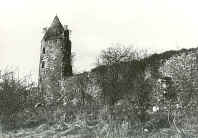
Sir Andrew Wood's Tower,
Upper Largo, Fife. (Photo: Gordon Wright)
first king to use such a method, but the
consequences of James's plan were to endure into modern times.
His chosen instruments were the Earl of
Huntly, head of the wide network of landowners of the Gordon family, whose
power base was in the north-east; and the Earl of Argyle, head of an even
more impressive array of Campbell chiefs in the west. The Huntly family
had been traditionally royalist and loyal; the then Earl had given vital
help to James II against Douglas allies in the 1450's, and in 1488 Huntly
had fought for his king, James III at Sauchieburn. The loyalty of the
Campbells went back even further to the days when Sir Neil Campbell of
Lochawe chose to serve and follow Robert Bruce, and founded the family
fortunes in so doing. So in the north-east and north, the Gordons acted
for the crown; and in the west it was now the Campbell galleys and
Campbell military power which was crucial.
The pacification of the Highlands and
Islands complete, James imposed order similarly in the Borders, and good
order for the future was to be guaranteed by a revised legal apparatus
involving a more or less permanent Law Court in Edinburgh, and by regular
tours of justiciars in support of local sheriffs in areas judged to be in
need of such supervision. James appears to have appreciated the advantages
of involving a wider proportion of his subjects in public affairs, and he
gave new importance to Parliament, requiring freeholders in the shires and
merchants in the burghs to participate in selection of representatives
and, if themselves selected, to undertake the obligations of parliamentary
business.
Peace and order achieved, James sought to
enhance the economic strength of his country. The long wars with England,
though not destroying Scottish independence, had gravely injured the
Scottish economy, as English invaders or retreating Scots burned and
destroyed crops and property at times almost annually. It has been
asserted that Scotland was economically stronger in the days of Alexander
III than in the days of James III. Now James and his advisers acted to
reform the currency, to impose standard measures of weight and volume, all
to inspire greater confidence in Scottish commerce. An export trade was
fostered with the establishment of a Scottish base, or 'staple', first at
Middelburg and then at Veere (or 'Campveere') in the Netherlands.
Domestic efficiency and commercial
improvement enhanced Scotland's influence abroad, and under James,
Scotland came to enjoy diplomatic importance. Scottish support was given
to, and welcomed by, Denmark under pressure from Swedish enemies; to
Guelders, against the Hapsburgs of Austria and, of course, to France,
enemy of England and England's allies, Spain and Austria.
In his relations with England, James had
been fortunate in having to deal with Henry VII, a ruler of the utmost
shrewdness and the least possible emotion, whose utter realism led him to
see that nothing useful was to be gained from stirring up trouble on his
northern border; and his calm even survived James's romantic support for
Perkin Warbeck who sought to overthrow Henry by claiming to be the
rightful Yorkist king of England. Warbeck's failure ended James's lapse
into folly, and entering into a truce with England, James it would seem,
was beginning to question the value of the French alliance. A change in
Scottish attitudes certainly seemed to be indicated by the marriage in
1503 of James and Margaret Tudor, daughter of Henry VII. Henry, an
ever-patient man, was content to see this drawing closer of Scotland and
England. To those in England who feared future Scottish influence, Henry
offered the reassurance that 'the greater will draw the less.'
In 1509 the English crown passed to Henry
VIII, the antithesis of his father - romantic, over-bearing, and
emotional, and a much more dangerous neighbour. Relations between England
and Scotland rapidly deteriorated. English ships attacked Andrew Barton at
sea, alleging piracy, and Henry was cold in his rejection of James's
complaints. In 1512 Henry, with his Spanish and Austrian allies in the
so-called 'Holy League', attacked France. James renewed the alliance with
France, but seems to have hoped to mediate rather than fight. But
skirmishing began along the Border; French defeats occurred, and the
French queen, who knew her man, appealed to James's romantic and
chivalrous streak, sending him herring, and asking him to 'break a lance'
in England for her sake.
This misguided vision of himself as a
knight, upon whom damsels in distress might call for aid, was the fatal
flaw in James's character. All his previous skill and experience were set
aside, as his honour was now appealed to. He called his army to muster on
the Burghmuir of Edinburgh and their response testifies to James's work in
uniting his country. From all parts of his country, and from families
often in past conflict with one another, they came to his summons.
With perhaps the largest Scottish army ever
assembled, James crossed the border, captured key English strongholds and
awaited the oncoming English army under the wily veteran, Surrey. As the
armies came in sight of each other on 9 September 1513, James committed
the deadly error of allowing Surrey to place his army between the Scots
and their road back to Scotland. His final error was to order the Scots to
leave their position upon Flodden Hill and toil over marshland to attack
the English. Superior technology again was decisive, not archers this
time, but guns, and the English infantry armed with 'bills' - short spears
with axe heads on their shafts. With their bills the English broke the
Scottish spears and were able to close in upon the tight Scottish ranks.
The Scottish right, under Argyle and Lennox broke; the left, under Huntly
and Home were victorious, but pursued their beaten adversaries, allowing
Surrey to close in upon the king and the Scottish centre. There King James
died with an English arrow in his throat and a bill wound on his head.
Around him lay twelve Scottish Earls; his young son Alexander, Archbishop
of St. Andrews; fifteen lesser lords and clan chiefs, and several thousand
of his countrymen. They fought on till darkness fell, and then made for
the Tweed and home. The road to Edinburgh lay open, and the city
authorities learned of the disaster from Randolph Murray, captain of the
Town Guard who had gone to Flodden and alone had survived.
Never was there such a disaster. Hardly a
family in Scotland had escaped bereavement, and a whole generation of
leaders had died in one afternoon. The new king, James V, was aged
eighteen months.
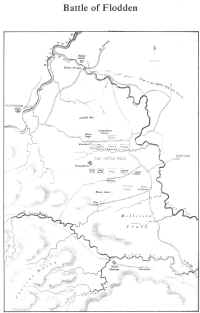 Edinburgh's
city leaders hastily built the Flodden Wall, and prepared to endure
English attack, but the victory at Flodden had not been without cost, and
Surrey was not in any position to press home an attack upon Scotland. So
the crisis passed, and indeed an age had ended. Future English attacks
would be made with some precise purpose, and no longer in any general
pursuit of conquest, overlordship and the like. Things had changed in both
countries, and the old medieval social patterns had begun to change with
them. Edinburgh's
city leaders hastily built the Flodden Wall, and prepared to endure
English attack, but the victory at Flodden had not been without cost, and
Surrey was not in any position to press home an attack upon Scotland. So
the crisis passed, and indeed an age had ended. Future English attacks
would be made with some precise purpose, and no longer in any general
pursuit of conquest, overlordship and the like. Things had changed in both
countries, and the old medieval social patterns had begun to change with
them.
In the mid 1400s there had occurred the
beginnings of that remarkable process which men came to know as 'the
Renaissance', when the marvellous capacities of the human mind seemed to
be released and respected as never before in Western Europe. It was not
perhaps really as new as it seemed. Many profound thinkers had lived and
expressed themselves all through the medieval centuries, but now there was
an excited feeling that man's own intellect was a marvellous gift; and
that using it he could examine and understand his world for himself. The
natural world of science and geography was appraised in this manner; the
function of literature and the arts was examined anew; philosophy as man's
deepest intellectual activity was revitalised, in this new spirit of
inquiry and experiment.
These ideas and events all had their impact
upon Scotland. In education, two universities already existed - St Andrews
founded in 1411 under Regent Albany and Glasgow in 1451 under James II.
Now, in 1495, Bishop Elphinstone founded King's College at Aberdeen; in
1496 an Act of Parliament was passed requiring landowners to have their
sons trained in Latin and Law, and in 1505 the College of Surgeons was
founded in Edinburgh. The Scots talent for architecture was displayed in
the royal buildings of Holyrood and Falkland, Linlithgow and Stirling; and
a generation - or perhaps two - of poets and authors produced a native
literature in which Scots ever since can take justified pride. Robert
Henryson, head of the Grammar School of Dunfermline, and, greatest of all,
William Dunbar, are poets who can stand in Chaucer's company. Gavin
Douglas and David Lindsay produced poetic dramas, Lindsay's Three Estates
being of particular cultural and historical importance. The Renaissance
spirit moved in Scotland, and King James had been the very model of a
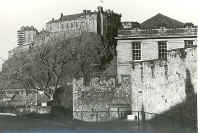
A remaining part of the
Flodden Wall at the Vennel in Edinburgh. (Photo: Gordon Wright)
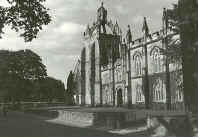
King's College, Old
Aberdeen. (Photo: Gordon Wright)
Renaissance prince - versatile,
intelligent, cultured and progressive.
But of course, these developments were of
significance mainly among the leisured classes. Study and reflection were
luxuries denied to a general public, mostly illiterate, working daylight
hours on the land. Their lives did not change essentially in the best part
of a thousand years.
Most people lived on and from the land. The
entire feudal system, from highest to lowest levels, was based upon
services performed in return for the use of land. The noble was bound to
serve the crown as a soldier, and to bring with him tenants who were
similarly bound to him.
The wealth of all - crown, church and
nobles - was based upon the produce of the land, worked for them by
tenants. The land was worked in teams, carrying through all the processes
of ploughing and sowing, reaping and threshing and milling, earning their
own livelihood, and sustaining their lords by their rentals paid usually
in the form of the produce of the season's work. In Scotland good,
productive land was scarce, and every acre had to earn its keep every
year. The 'infield' was the land which could bear a crop each year, it was
ploughed and allocated, by lot and, probably, by rota, to each household
contributing to the work. The 'outfield' was the land of inferior quality,
which otherwise was used mainly as pasture or rough grazing. Productivity
was not impressive.
The old Scots saying 'ane tae saw, ane tae
gnaw, ane tae pay the laird witha' testifies to the expectation of a
threefold return - one third kept as seed for the coming year, one third
to feed the people, and the remaining third to go in rent to the
landowner.
There were good years and bad, as always.
Sometimes the produce of one harvest was consumed before the new harvest
could be gathered, and people then had to scrape a living from wild
plants, fish, and the like. Each year, as has been said, was a rehearsal
for famine, and sometimes the famine came. Some animals at the end of each
season, were preserved for breeding, and the others slaughtered, because
there was not enough fodder to see all through the winter. Often the
animals which had been spared were so weak that they had to be carried out
to the fields when the new growth appeared on the grass. The 'lifting'
became virtually an annual ritual. The slaughtered animals were salted,
and the salt meat consumed as the winter dragged on. Scurvy afflicted
those who made this their diet. In summer and autumn milk and cheese with
meal and through time, peas and beans, gave a more balanced diet.
Class privilege affected diet and health.
The landowners kept pigeons, and allowed game animals - deer and hares -
to live on their land. They thus had a supply of fresh meat throughout the
year and woe betide the tenant who took one of these beasts for himself.
Towns and villages developed as centres for
the marketing of any surplus produce, and as bases for the various
craftsmen whose skills were relevant to the land - smiths, masons,
farmers, weavers for instance. Every village, every town, every city was
built on some lord's land, and that lord could grant such privileges as he
wished to the people of the town. This was commonly done by the granting
of a charter - a document detailing the rights granted, and the
obligations undertaken. These charters were proof of the bargain, and men
realised fully the importance of legal proof. The men of the medieval
centuries were notably concerned with legalities, and a notion of the
fundamental importance of law was bred in them.
To towns granted charters to hold markets
and fairs there was applied the name 'burghs'. If a burgh was on church
land - like Dunfermline or St. Andrews, Paisley or Glasgow - it was an
ecclesiastical burgh, its charter coming from the Abbot; if on the land of
a secular lord - like Greenock or Kilmarnock - it was a 'burgh of barony';
but if its charter came from the crown, it was a Royal burgh, with special
rights and status. Royal burghs held a monopoly for instance in foreign
trade, import and export, which no lesser burgh could infringe; and Royal
burghs sent commissioners to the Scottish parliament. Kings saw useful
political opportunities, and granted charters in areas where they knew
themselves to be popular. Thus King James III gave charters to many of the
small towns around the Moray coast, and James IV raised improbably small
Fife villages to Royal burgh status.
The Royal burghs were conscious of their
superiority which they guarded carefully, and the Convention of Royal
Burghs watched keenly for any challenge or any infringement.
Within the burghs there developed Gilds,
whose members pursued a common trade or profession. The craft gilds -
Bakers, Wrights, Fleshers - regulated standards of work, licensed
apprentices and disciplined craftsmen in the public interest. At a higher
social and financial level there was one merchant Gild, organising all the
overseas commerce of the town.
Scots exports were very practical and
showed the comparative poverty of the country. Salt and salted fish; wool
and linen, hides and leather, coal - these were the products which found
their way to the Netherlands, to Scandinavia and the Baltic, to France and
most of all to England.
England was the only country with which
Scotland could trade overland, and the biggest single Scottish export,
live cattle, went to England. In days to come, trade with Europe
diminished and trade with England increased, and this dependence upon
English custom had profound political consequences.
Meanwhile the merchants prospered visibly.
They imported fine fabrics, scents, spices, jewels and finely crafted
metal, for sale to court and castle and, of course, for themselves and
their families. The merchants were the sophisticates of their society,
which made whatever international contacts it experienced through them.
The burghs became, therefore, more
cultured, more wordly-wise, more in touch with new ideas, than the rural
communities, and increasingly influential in national affairs as time
passed.
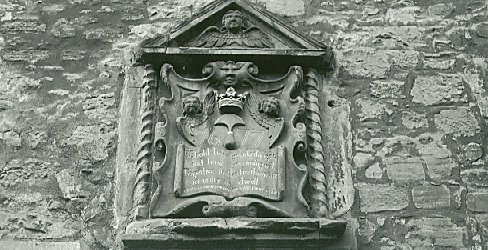
A Sculptured shield
including the arms of the Guild of Shoemakers, Canongate, Edinburgh.
(Photo: Gordon Wright) |

